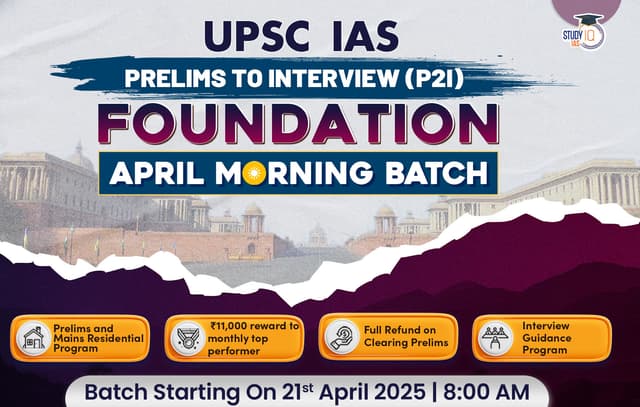Daily Quiz 15 February 2025
Quiz-summary
0 of 5 questions completed
Questions:
- 1
- 2
- 3
- 4
- 5
Information
- Click on – ‘Start Quiz’ button
- Solve Questions
- Click on ‘Next’ button
- Click on ‘Finish Quiz’ button
- Now click on ‘View Questions’ button – here you will see solutions and links.
- The test contains a total of 5 questions.
- Click on the most appropriate option to mark it as your answer.
- You will be awarded Two marks for each correct answer.
- You can change your answer by clicking on some other option.
- A Number list of all questions appears at the top side of the screen.
- You can access the questions in any order by clicking on the question number given on the number list.
- You can use rough sheets while taking the test.
- Do not use calculators, log tables, dictionaries, or any other printed/online reference material during the test.
- Do not click the button “Finish Quiz” before completing the test. A test once submitted cannot be resumed.
You have already completed the quiz before. Hence you can not start it again.
Quiz is loading...
You must sign in or sign up to start the quiz.
You have to finish following quiz, to start this quiz:
- 1
- 2
- 3
- 4
- 5
- Answered
- Review
-
Question 1 of 5
1. Question
1 pointsConsider the following statements regarding El Niño and La Niña:
- El Niño occurs when trade winds weaken, leading to warmer-than-usual temperatures in the eastern Pacific Ocean.
- La Niña leads to a global increase in temperatures, while El Niño causes a global drop in temperatures.
- Both El Niño and La Niña phases can impact global weather patterns, but their intensity and effects vary with each cycle.
- In the neutral phase of ENSO, the eastern Pacific Ocean is warmer than the western Pacific Ocean.
Which of the statements given above are correct?
Correct
Answer: A
Explanation:
- El Niño Southern Oscillation (ENSO) is a climate phenomenon characterised by changes in sea temperatures along the central and eastern tropical Pacific Ocean, accompanied by fluctuations in the atmosphere overhead. ENSO influences, alters, and interferes with global atmospheric circulation, which, in turn, influences the weather worldwide. ENSO has three phases — warm (El Niño), cool (La Niña), and neutral — which occur in irregular cycles of two to seven years.
- Statement 1 is correct: El Niño occurs when trade winds weaken, reducing the displacement of warm water from the eastern Pacific, resulting in warmer-than-usual temperatures in that region.
- Statement 2 is not correct: La Niña generally leads to a drop in global temperatures, while El Niño increases global temperatures.
- Statement 3 is correct: Both El Niño and La Niña affect global weather patterns, but their intensity, duration, and regional effects vary with each cycle.
Statement 4 is not correct: In the neutral phase of ENSO, the eastern Pacific is cooler than the western Pacific due to the prevailing east-to-west trade winds, which push warm surface waters toward the western Pacific (Indonesian coast). The relatively cooler waters from below come up to replace the displaced water.
Incorrect
Answer: A
Explanation:
- El Niño Southern Oscillation (ENSO) is a climate phenomenon characterised by changes in sea temperatures along the central and eastern tropical Pacific Ocean, accompanied by fluctuations in the atmosphere overhead. ENSO influences, alters, and interferes with global atmospheric circulation, which, in turn, influences the weather worldwide. ENSO has three phases — warm (El Niño), cool (La Niña), and neutral — which occur in irregular cycles of two to seven years.
- Statement 1 is correct: El Niño occurs when trade winds weaken, reducing the displacement of warm water from the eastern Pacific, resulting in warmer-than-usual temperatures in that region.
- Statement 2 is not correct: La Niña generally leads to a drop in global temperatures, while El Niño increases global temperatures.
- Statement 3 is correct: Both El Niño and La Niña affect global weather patterns, but their intensity, duration, and regional effects vary with each cycle.
Statement 4 is not correct: In the neutral phase of ENSO, the eastern Pacific is cooler than the western Pacific due to the prevailing east-to-west trade winds, which push warm surface waters toward the western Pacific (Indonesian coast). The relatively cooler waters from below come up to replace the displaced water.
-
Question 2 of 5
2. Question
1 pointsConsider the following statements with reference to PM POSHAN Scheme:
- It is a Centrally Sponsored Scheme which serves hot cooked meal to school children studying in Classes I-12th of Government and Government aided schools.
- It envisages to provide a cooked meal with 450 calories and 12 g of protein to every child at primary level.
- It is mandatory to provide eggs in the meal at least for half the days in a working month all over India.
How many of the above statements are correct?
Correct
Answer: A
Explanation:
- Statements 1 is not correct: PM Poshan is a Centrally Sponsored Scheme which serves hot cooked meal to school children studying in Classes I-VIII of Government, Government aided schools, Special Training centres (STC) and Madarasas and Maktabs supported under Samagra Shiksha Scheme.
- Statement 2 is correct: The PM POSHAN guidelines envisage to provide a cooked meal with 450 calories and 12 g of protein to every child at primary level and 700 calories and 20g of protein at upper primary level. This energy and protein requirement for a primary child comes from cooking 100g of rice/flour, 20g pulses and 50g vegetables and 5g oil, and for an upper primary child it comes from 150g of rice/flour, 30g of pulses and 75g of vegetables and 7.5g of oil.
- Statement 3 is not correct: It is not mandatory to provide eggs in the meal at least for half the days in a working month all over India. Nearly 16 States have eggs on the midday meal menu.
- Objectives of the Scheme:
- Improving the nutritional status of children in classes I – VIII in Government, Local Body , Government aided schools, EGS and AIE centers.
- Encouraging poor children, belonging to disadvantaged sections, to attend school more regularly and help them to concentrate on classroom activities.
Providing nutritional support to children of primary stage in drought-affected areas during summer vacation.
Incorrect
Answer: A
Explanation:
- Statements 1 is not correct: PM Poshan is a Centrally Sponsored Scheme which serves hot cooked meal to school children studying in Classes I-VIII of Government, Government aided schools, Special Training centres (STC) and Madarasas and Maktabs supported under Samagra Shiksha Scheme.
- Statement 2 is correct: The PM POSHAN guidelines envisage to provide a cooked meal with 450 calories and 12 g of protein to every child at primary level and 700 calories and 20g of protein at upper primary level. This energy and protein requirement for a primary child comes from cooking 100g of rice/flour, 20g pulses and 50g vegetables and 5g oil, and for an upper primary child it comes from 150g of rice/flour, 30g of pulses and 75g of vegetables and 7.5g of oil.
- Statement 3 is not correct: It is not mandatory to provide eggs in the meal at least for half the days in a working month all over India. Nearly 16 States have eggs on the midday meal menu.
- Objectives of the Scheme:
- Improving the nutritional status of children in classes I – VIII in Government, Local Body , Government aided schools, EGS and AIE centers.
- Encouraging poor children, belonging to disadvantaged sections, to attend school more regularly and help them to concentrate on classroom activities.
Providing nutritional support to children of primary stage in drought-affected areas during summer vacation.
-
Question 3 of 5
3. Question
1 pointsConsider the following statements with reference to blood groups:
- In normal individuals, the H antigen serves as the base structure for building A and B antigens.
- In Bombay blood group individuals, the gene responsible for producing the H antigen is mutated or absent.
Which of the statements given above is/are correct?
Correct
Answer: C
Explanation:
- Statements 1 and 2 are correct: The Bombay, a.k.a. HH, blood group is a rare blood group first discovered in Mumbai in 1952 by Y.M. Bhende. The key differences between the Bombay blood group and the common ABO blood groups lie in the presence (or absence) of the H antigen, which is the fundamental building block for the ABO blood group system.
- In normal individuals, the H antigen serves as the base structure for building A and B antigens. In Bombay blood group individuals, the gene responsible for producing the H antigen is mutated or absent, so neither A nor B antigens can be formed.
Therefore, these people cannot receive blood transfusions from any ABO group, including type O, which has the H antigen. They can only receive blood from another Bombay blood group donor. Its prevalence is about 0.0004% (one in 4 million) of the total human population.
Incorrect
Answer: C
Explanation:
- Statements 1 and 2 are correct: The Bombay, a.k.a. HH, blood group is a rare blood group first discovered in Mumbai in 1952 by Y.M. Bhende. The key differences between the Bombay blood group and the common ABO blood groups lie in the presence (or absence) of the H antigen, which is the fundamental building block for the ABO blood group system.
- In normal individuals, the H antigen serves as the base structure for building A and B antigens. In Bombay blood group individuals, the gene responsible for producing the H antigen is mutated or absent, so neither A nor B antigens can be formed.
Therefore, these people cannot receive blood transfusions from any ABO group, including type O, which has the H antigen. They can only receive blood from another Bombay blood group donor. Its prevalence is about 0.0004% (one in 4 million) of the total human population.
-
Question 4 of 5
4. Question
1 pointsConsider the following statements with reference to National Council for Teacher Education:
- It is an executive body created by a resolution in pursuance of National Policy on Education (NPE), 1986.
- It lays down guidelines in respect of minimum qualifications for a person to be employed as a teacher in schools or in recognized institutions.
- It has re-introduced the one-year Bachelor of Education (B.Ed) program effective from the 2026-27 academic session.
How many of the above statements are correct?
Correct
Answer: B
Explanation:
- Statement 1 is not correct: The National Council for Teacher Education, in its previous status since 1973, was an advisory body for the Central and State Governments on all matters pertaining to teacher education. The National Policy on Education (NPE), 1986 and the Programme of Action thereunder, envisaged a National Council for Teacher Education with statutory status and necessary resources as a first step for overhauling the system of teacher education. The National Council for Teacher Education as a statutory body came into existence in pursuance of the National Council for Teacher Education Act, 1993.
- Statement 2 is correct: It shall be the duty of the Council to take all such steps as it may think fit for ensuring planned and co-ordinated development of teacher education and for the determination and maintenance of standards for teacher education and for the purposes of performing its functions under this Act, the Council may:
- undertake surveys and studies relating to various aspects of teacher education and publish the result thereof.
- make recommendations to the Central and State Government, Universities, University Grants Commission and recognized institutions in the matter of preparation of suitable plans and programmes in the field of teacher education.
- co-ordinate and monitor teacher education and its development in the country.
- lay down guidelines in respect of minimum qualifications for a person to be employed as a teacher in schools or in recognized institutions.
Statement 3 is correct: The National Council for Teacher Education (NCTE) has announced a significant reform in teacher education by reintroducing the one-year Bachelor of Education (B.Ed) program after nearly a decade. Effective from the 2026-27 academic session, this move marks a shift from the two-year B.Ed course introduced in 2014. The decision aligns with the National Education Policy (NEP) 2020, which emphasizes flexible learning pathways and diverse entry options for aspiring educators.
Incorrect
Answer: B
Explanation:
- Statement 1 is not correct: The National Council for Teacher Education, in its previous status since 1973, was an advisory body for the Central and State Governments on all matters pertaining to teacher education. The National Policy on Education (NPE), 1986 and the Programme of Action thereunder, envisaged a National Council for Teacher Education with statutory status and necessary resources as a first step for overhauling the system of teacher education. The National Council for Teacher Education as a statutory body came into existence in pursuance of the National Council for Teacher Education Act, 1993.
- Statement 2 is correct: It shall be the duty of the Council to take all such steps as it may think fit for ensuring planned and co-ordinated development of teacher education and for the determination and maintenance of standards for teacher education and for the purposes of performing its functions under this Act, the Council may:
- undertake surveys and studies relating to various aspects of teacher education and publish the result thereof.
- make recommendations to the Central and State Government, Universities, University Grants Commission and recognized institutions in the matter of preparation of suitable plans and programmes in the field of teacher education.
- co-ordinate and monitor teacher education and its development in the country.
- lay down guidelines in respect of minimum qualifications for a person to be employed as a teacher in schools or in recognized institutions.
Statement 3 is correct: The National Council for Teacher Education (NCTE) has announced a significant reform in teacher education by reintroducing the one-year Bachelor of Education (B.Ed) program after nearly a decade. Effective from the 2026-27 academic session, this move marks a shift from the two-year B.Ed course introduced in 2014. The decision aligns with the National Education Policy (NEP) 2020, which emphasizes flexible learning pathways and diverse entry options for aspiring educators.
-
Question 5 of 5
5. Question
1 pointsWhich one of the following best describes Tirzepatide, recently seen in the news?
Correct
Answer: B
Explanation:
Option B is correct: Tirzepatideis a novel glucose‐dependent insulinotropic polypeptide/glucagon‐like peptide 1 (GLP‐1) receptor agonist approved in the United States as an adjunct to diet and exercise to improve glycaemic control in adults with type 2 diabetes and under investigation for use in chronic weight management, major adverse cardiovascular events and the management of other conditions, including heart failure with preserved ejection fraction and obesity and non‐cirrhotic non‐alcoholic steatohepatitis.
Incorrect
Answer: B
Explanation:
Option B is correct: Tirzepatideis a novel glucose‐dependent insulinotropic polypeptide/glucagon‐like peptide 1 (GLP‐1) receptor agonist approved in the United States as an adjunct to diet and exercise to improve glycaemic control in adults with type 2 diabetes and under investigation for use in chronic weight management, major adverse cardiovascular events and the management of other conditions, including heart failure with preserved ejection fraction and obesity and non‐cirrhotic non‐alcoholic steatohepatitis.
Results
0 of 5 questions answered correctly
Your time:
Time has elapsed
You have reached 0 of 0 points, (0)
| Average score |
|
| Your score |
|
Categories
- Not categorized 0%
| Pos. | Name | Entered on | Points | Result |
|---|---|---|---|---|
| Table is loading | ||||
| No data available | ||||
Sharing is caring!

 Daily Quiz 18 April 2025
Daily Quiz 18 April 2025
 Daily Quiz 17 April 2025
Daily Quiz 17 April 2025





















